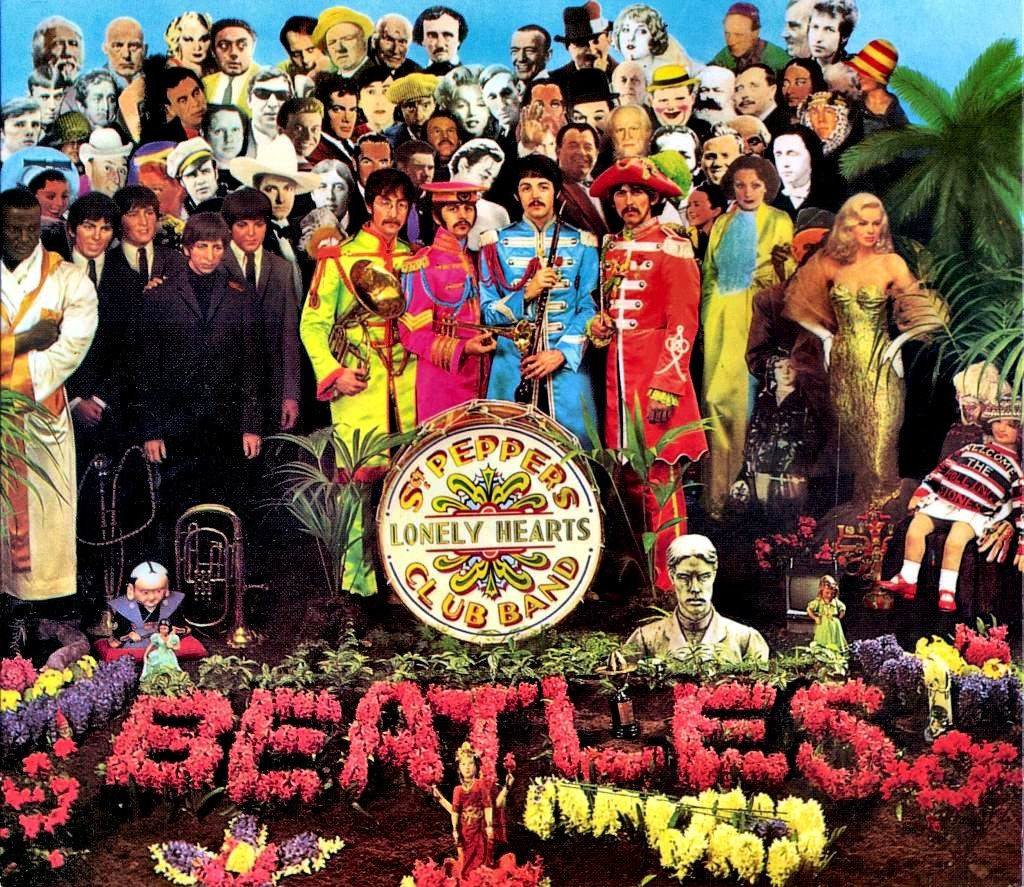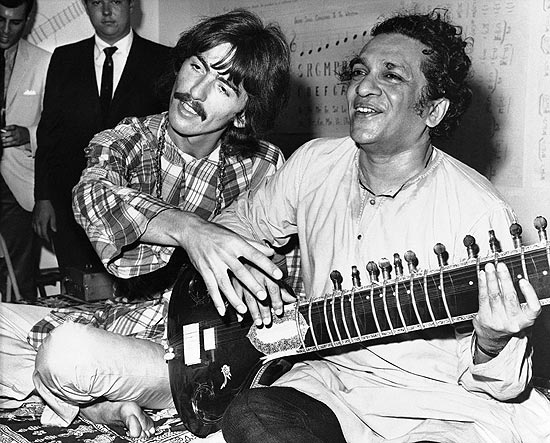
Today’s Throwback Thursday post is true trip back to the past – to the 1960’s and the release of one of the most seminal albums of all time, from the album art, to the album concept, and of course the grooves of the vinyl itself. I was a high school teenager when the Beatles’ masterwork was released, and it was absolutely buzzworthy. It was what we were talking about because it was something very different from one of the most culturally influential bands of all time.
It’s hard to imagine a band or solo performer generating that much interest in today’s “long tail” music world. Now we talk about Taylor Swift’s merch.
When I think about how the Classic Rock format evolved, I always think about the Beatles as the foundation. As the band that launched what would become the British Invasion, it’s a little odd we don’t hear the Beatles a whole lot any more on the radio dial in the 2020s.
Classic Rock stations would rather play Grunge than anything from the 60s. And most Classic Hits stations have become 80s machines. Meanwhile, SiriusXM’s Beatles channel endures. – FJ
April 2017
Last week, I was conducting one-on-one interviews for a group of stations we work with. A 32 year-old guy named Christian (pictured below) walked into the conference room sporting a Jimi Hendrix concert T-shirt. As our discussion progressed, he told me how much he loves vintage rock, driven by a nagging feeling he missed out on something special because he was too young to experience the ’60s music phenomenon. In the qualitative research I’ve done, combined with the ratings and perceptual studies I’ve seen, there are a lot of young guys like him all over the country.
The truth is, he actually did miss a lot. As someone old enough to have enjoyed that music in “real time,” the memories sometimes obscure and even embellish the reality of what was really going on back then. Part of the story was the many groundbreaking historic moments 50 years ago. Race riots, the Vietnam war, and other big events dominated newspaper headlines.
But in the world of music in 1967, the major buzz was the release of another Beatles album. Back then, these events were reminiscent of the debut of an Apple iPhone, complete with long lines of fans who had to have the record on the very first day it went on sale. But the Beatles’ iconic “Sgt. Pepper’s Lonely Hearts Club Band” album, released a half century ago, became an even bigger thing. Today, there’s a lot of hoopla surrounding the golden anniversary of this record. And for good reason.
So over the long holiday weekend, I took a moment to stop and think about its import and impact – what it meant to music, society, culture, and radio back then – and what it means to us today.
When “Sgt. Pepper’s” came out, the Beatles were already the biggest thing going, selling millions of albums and dominating radio airplay. America loved the Fab Four, so when they “broke format” and released “Sgt. Pepper’s,” it was more than just a musical fork in the road. It became a cultural turning point.
The Beatles disrupted themselves. And they did it at a time when they were the most popular band on the planet. “Revolver” was released in  1966, one year earlier, and it was a brilliant piece of work.
1966, one year earlier, and it was a brilliant piece of work.
But “Sgt. Pepper’s” blew up the band’s consistent, familiar repertoire, forcing Beatle fans to sit up and take notice. Gone were the simple melodies, the love ballads, and the 2:30 radio-friendly songs. Instead, this album broke the mold, and paved the way for rock bands to redefine and reinvent themselves. Around that time, George Harrison was quoted by biographer Hunter Davies:
“I don’t personally enjoy being a Beatle anymore.”
George was an important force on the album, singlehandedly introducing new sounds. In the grooves, the Beatles reinvented themselves with “Sgt. Pepper’s” – not once, but several times. The debut of the sitar on “Within You Without You” was one of many firsts brought to the band by George, inspired by Ravi Shankar.
Interestingly, some of the Beatles’ core fans were appalled at the album. It was too weird and psychedelic. It wasn’t lovable or cute. Songs like “A Day In The Life” were textured, cacophonous, different, and not Top 40 AM radio-friendly. They stirred up conversation as fans debated the blurry stories buried deep within the vinyl.
And it wasn’t just the music – it was the look, the packaging, and the album art. This was an LP you sat down with, you stared at, you thought about, and you discussed. It was carefully sequenced, songs sequed into each other, it was themed out, and it told stories. Up to that point, most albums were exercises in stringing together a bunch of songs around a hit single or two – enough music to fill two sides of a 33⅓ record album. “Sgt. Pepper’s” was a concept album, with themes that stretched the boundaries of rock as we knew it.
 Just gazing at the montage of people on the cover scene became its own conversation. Who were all those faces, what did they symbolize, and what compelled the Beatles to choose them? Of course, it was not possible to Google the album or discuss it on Facebook, so you had to work it out for yourself. While obvious faces like W.C. Fields, Mae West, Stan Laurel, and Bob Dylan jumped out, identifying Oscar Wilde (pictured left), Huntz Hall, Lenny Bruce, and James Joyce was considerably more challenging.
Just gazing at the montage of people on the cover scene became its own conversation. Who were all those faces, what did they symbolize, and what compelled the Beatles to choose them? Of course, it was not possible to Google the album or discuss it on Facebook, so you had to work it out for yourself. While obvious faces like W.C. Fields, Mae West, Stan Laurel, and Bob Dylan jumped out, identifying Oscar Wilde (pictured left), Huntz Hall, Lenny Bruce, and James Joyce was considerably more challenging.
BBC Music has created a wonderful series of videos, going into their vast archives and breaking down each of the faces on the album cover with short videos. That would have come in handy 50 years ago.
If there was such a thing as going viral in 1967, “Sgt. Pepper’s” achieved it. While many music critics believe other Beatle albums were better musically (“Abbey Road” is often mentioned), “Sgt. Pepper’s” ought to win the award for most groundbreaking album – ever.
Oddly enough, the Grammys got it right. “Sgt. Pepper’s” won album of the year in ’68, and designers Jann Haworth and Peter Blake took top honors for best album cover.
“Sgt. Pepper’s” was a sure sign the Beatles burned out on being the Beatles, long before the rest of us did. And unlike most bands that would have been content to continue releasing hit albums regurgitating their patented sound, “Sgt. Pepper’s” was a message to their millions of fans:
“We’re moving over here now and taking a very different journey. You’re welcome to join us. But if not, you have our wonderful older albums to enjoy.”
The travelers who made the episodic trek often ended up becoming Classic Rock fans, while those who stayed behind, preferring the more melodious sound, innocence, and simplicity of “She Loves You” and “Eight Days A Week” tended to gravitate to Oldies stations. It was like after years of mainstream comedies, the Beatles released a foreign film – without the subtitles. Not everyone “got it.”
“Sgt. Pepper’s” was the gateway drug (in some cases, quite literally) to Pink Floyd, Yes, and rock that went well beyond hit singles and mainstream airplay at powerhouses like KHJ, WLS, and CKLW.
But that’s why the Beatles were…the Beatles. Always leading, never following, they took us on a trip that has continued to this day. The seeds of FM radio’s rise were firmly planted with that album, fueling a group of upstart revolutionary stations on the chance to be different and even counter-culture.
The Beatles albums that followed – “Magical Mystery Tour,” “The Beatles” (White Album), “Yellow Submarine,” “Abbey Road,” and “Let It Be” – all continued the journey, moving further away from being fab, and scoping out new musical and cultural turf.
It is impossible to imagine another album (or video or film) that could possibly have the sweeping impact “Sgt. Pepper’s” did. And that’s why  this breakthrough album is worth celebrating, whether you grew up with the Beatles or you discovered this masterwork at some point later on like many thirtysomethings have done.
this breakthrough album is worth celebrating, whether you grew up with the Beatles or you discovered this masterwork at some point later on like many thirtysomethings have done.
For me personally, the album signaled a music transition, opening me up to bands and albums that would become a catalyst for my own career in radio, and later, the development of the Classic Rock format.
For young guys like Christian, it is a point in time he’ll never personally know, but he can still enjoy and appreciate through classic recordings like “Sgt. Pepper’s.”
Celebrating the 50th anniversary of “Sgt. Pepper’s Lonely Hearts Club Band” brings a lytic from the title track to mind:
“It’s certainly a thrill.”
P.S. Yes, Christian is sporting “the old English D” – the symbol of Detroit. Yet, these intervews took place more than 1,000 miles away, and Christian told me he never lived in the Motor City. He’s just a fan of the Red Wings and Tigers. Go figure.
- A 2020 Lesson?It Could All Be Gone In A Flash - April 24, 2025
- How AI Can Give Radio Personalities More…PERSONALITY - April 23, 2025
- Can Radio Afford To Miss The Short Videos Boat? - April 22, 2025





Let me be the first to thank you for the BBC page link. This will keep me busy for hours…
I checked it to before reposting it for #TBT and was thrilled the BBC didn’t take it down. It’s a nice piece of Internet work.
I so remember the day the album was released. I was a sophomore in college and WNEW-FM here in New York suspended all programming that afternoon to play the whole album. It was a great afternoon.
And why not? But can you imagine radio doing that today? For anything? No, me neither.
Can it be a coincidence that, in the city by the bay, KMPX and then KSAN were among the first “free form” FM stations to come into existence in the year Sgt Pepper was released? I think not. Those stations, and their like springing up in cities across the country, introduced a new generation of listeners to radio’s potential; and it’s not exaggerating to suggest that, without them, the classic-rock format wouldn’t later have found the ears it needed to develop the legs it has run with.
BTW, Harrison brought his sitar to earlier Beatles LPs: “Norwegian Wood” on Rubber Soul, and “Love You To” on Revolver. From the perspective of half a century later, many rock critics consider the latter album more revolutionary than Sgt Pepper. But that’s a topic for a different cocktail party.
I’m ready to buy that next round, John, and have that conversation. It is interesting the album’s release coincides with the birth of FM prog rock radio. Not a coincidence.
I probably posted this link the first time you ran this great column, but let’s do it again. A good time is guaranteed for all.
https://exchange.prx.org/pieces/18227-the-two-sides-of-sgt-pepper-an-honest-appraisal
If any of your current radio clients want to run it, maybe for the big 56th anniversary in June (traditionally a BIG one everyone wants to mark!) then have them get in touch with me.
Paul (the cute one) Ingles 505-255-1219
I’m glad you reposted. This thing’s coming up in a minute. When I worked with WCXR in D.C., for the 20th anniversary, we made up a life-sized cover of the album with a couple holes where people like Oscar Wilde was. You could stick your head in the “album cover” and take a photo on your Instamatic camera. We got permission to place the standup in area malls. It was huge, as you can imagine. I hope you get some calls, and thanks for the comment.